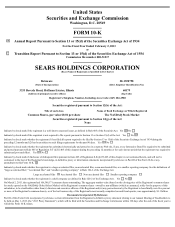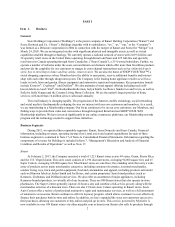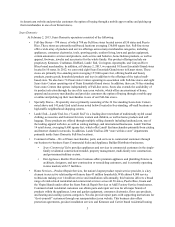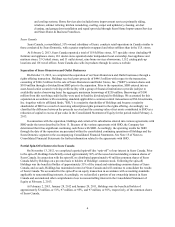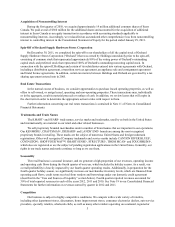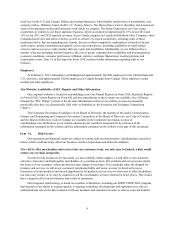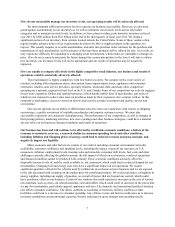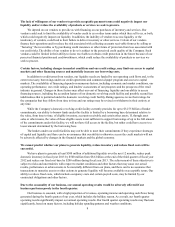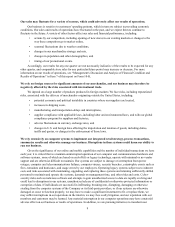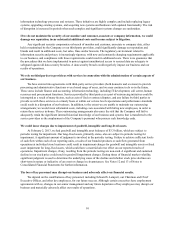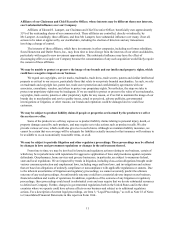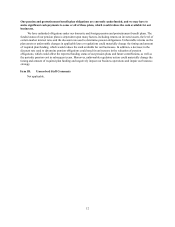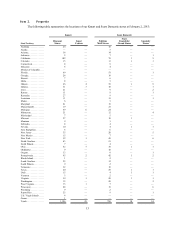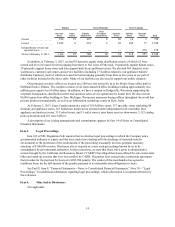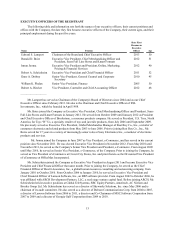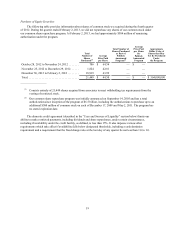Sears 2012 Annual Report Download - page 9
Download and view the complete annual report
Please find page 9 of the 2012 Sears annual report below. You can navigate through the pages in the report by either clicking on the pages listed below, or by using the keyword search tool below to find specific information within the annual report.9
Our sales may fluctuate for a variety of reasons, which could adversely affect our results of operations.
Our business is sensitive to customers' spending patterns, which in turn are subject to prevailing economic
conditions. Our sales and results of operations have fluctuated in the past, and we expect them to continue to
fluctuate in the future. A variety of other factors affect our sales and financial performance, including:
• actions by our competitors, including opening of new stores in our existing markets or changes to the
way these competitors go to market online,
• seasonal fluctuations due to weather conditions,
• changes in our merchandise strategy and mix,
• changes in population and other demographics, and
• timing of our promotional events.
Accordingly, our results for any one quarter are not necessarily indicative of the results to be expected for any
other quarter, and comparable store sales for any particular future period may increase or decrease. For more
information on our results of operations, see “Management's Discussion and Analysis of Financial Condition and
Results of Operations” in Item 7 of this report on Form 10-K.
We rely on foreign sources for significant amounts of our merchandise, and our business may therefore be
negatively affected by the risks associated with international trade.
We depend on a large number of products produced in foreign markets. We face risks, including reputational
risks, associated with the delivery of merchandise originating outside the United States, including:
• potential economic and political instability in countries where our suppliers are located,
• increases in shipping costs,
• manufacturing and transportation delays and interruptions,
• supplier compliance with applicable laws, including labor and environmental laws, and with our global
compliance program for suppliers and factories,
• adverse fluctuations in currency exchange rates, and
• changes in U.S. and foreign laws affecting the importation and taxation of goods, including duties,
tariffs and quotas, or changes in the enforcement of those laws.
We rely extensively on computer systems to implement our integrated retail strategy, process transactions,
summarize results and otherwise manage our business. Disruptions in these systems could harm our ability to
run our business.
Given the significance of our online and mobile capabilities and the number of individual transactions we have
each year, it is critical that we maintain uninterrupted operation of our computer and communications hardware and
software systems, some of which are based on end-of-life or legacy technology, operate with minimal or no vendor
support and are otherwise difficult to maintain. Our systems are subject to damage or interruption from power
outages, computer and telecommunications failures, computer viruses, security breaches, catastrophic events such as
fires, tornadoes and hurricanes, and usage errors by our employees. Operating legacy systems subject us to inherent
costs and risks associated with maintaining, upgrading and replacing these systems and retaining sufficiently skilled
personnel to maintain and operate the systems, demands on management time, and other risks and costs. Cyber-
security risks such as malicious software and attempts to gain unauthorized access to data are rapidly evolving and
could lead to disruptions in our systems, unauthorized release of confidential or otherwise protected information or
corruption of data. If individuals are successful in infiltrating, breaking into, disrupting, damaging or otherwise
stealing from the computer systems of the Company or its third-party providers, or if our systems are otherwise
damaged or cease to function properly, we may have to make a significant investment to fix or replace them, we
may suffer interruptions in our operations in the interim, we may face costly litigation, and our reputation with our
members and customers may be harmed. Any material interruption in our computer operations may have a material
adverse effect on our business or results of operations. In addition, we are pursuing initiatives to transform our

